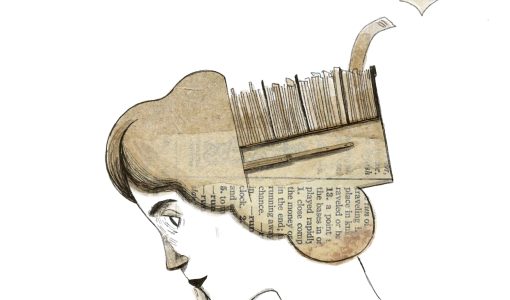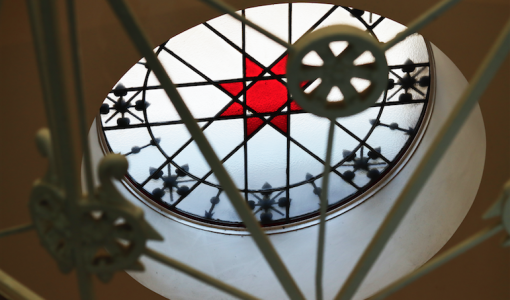
Rainer Oldendorf
Home
›
Exhibitions
›
Rainer Oldendorf
Rainer Oldendorf (Lüchow, 1961) uses architecture, light, photography, film and video in a work that proposes a reflection on his own personal, social and political history in the context of the places where it is produced and in relation to the people who have worked on a common project.
In that way he involves both the community that takes him in and the spectator, in an exercise that shifts the public space to the private one, the real space to the fictitious one, between photography and film.
Levels 2 and 3, the auditorium and the terrace of the Fundació Antoni Tàpies are the spaces Rainer Oldendorf will use for his exhibition in Barcelona. On this occasion the architectural conditions of the building have not been varied; Oldendorf has accepted them in the way a guest adapts to his hosts’ home, adding a few trifling elements that make him feel more at ease. In earlier projects, such as STUDIO/CINEMA (1992), done at the Le Corbusier Unity House in Marseille, or QP 71 (1993) -the title refers to a type of public housing typical of the GDR- in Berlin, Oldendorf had already turned his dwelling into an exhibition room, which enabled him to live and think different architectural situations concerning his own film and pictorial-photographic work. His current exhibition poses a new type of relation that emerges from both the characteristics of the building itself and the exhibition project, in this case, showing different levels of his work.
On level 2 of the Fundació Antoni Tàpies, the installation (communication is the word he prefers) combines two spaces devoted to his photographic work and another two that refer us to his Marco project. On the walls at the entrance, a selection of printed material including posters for the different parts of his film-installation Marco 1 to 5 (1995-1997) gives us a foretaste of a dislocated, continuous, changing and unfinished project, shot in different cities (Düsseldorf, Lyon, Tel Aviv, New York and Paris) and different languages (French, English, German, Hebrew…). A journey through a series of colour images leads us to dark central room where Marco 1 to 5 is being shown. It is a 16 mm film transferred to video, accompanied by a slide show with 40 slides repeated throughout the video. The slides, which are taken from the film, either related to the action or totally independent, introduce another time into the linear unfolding of the plot of the film, a circular time in which memory is activated and disintegrated, renewing itself freely in each spectator. On the way out of the projection room, new images await us. The photographs arranged in the two spaces converse with one another and other elements, other formal or narrative questions, intervene in their layout. The passage from artificial light to daylight and the red-painted outside wall of the room where Marco 1 to 5 is being shown model the skin of the images and interfere with their reception.
Oldendorf’s images always refer us to physical presences: His portraits, situations or inner and outer landscapes are not constructions made in a studio; they are photographs of his friends or people who, at particular moments and for different reasons, have been close to him. Those people do not stare impassively at the camera, nor are they static images; they are coming from one place and heading for another, they are passing by. They exist in a time and place and are incorporated into the story, they emerge from the awareness of a relationship, of new encounters that Oldendorf or other characters have in the places they visit. They are images that proceed from his interior and which chance or coincidence bring back to life in the present. Like the hero of his film, the artist, as a photographer, adopts a plurality of characters; images lead to others in a continuum where memory and imagination act tirelessly to construct a fiction which is introduced into daily action, that invisible action which is nevertheless capable of creating the spaces of freedom the spectator can occupy. Likewise, the film Marco is, especially as far as its production and reception are concerned, the before and after, what remains out of field.
We can continue our tour of the exhibition by one of three possible routes: the auditorium, where Marco 6 to 9, a 35 mm film made in Bilbao, Kyoto, Lörrach and Barcelona and transferred to video, is being shown. It is a film which, though carrying on from his earlier work, is conceived independently, as a unitary structure with no slide accompaniment. We can also choose to go down to the lower level, where earlier works are on display: an archive-space where we can see a series of vintage prints done by Oldendorf’s grandfather, who was a civil engineer and amateur photographer. The archive of images, duly catalogued and consisting mainly of negatives, was given to Oldendorf. From that archive he made The Photos of Walter Behrle (1994), an installation which brings together works from three quite different periods: present day copies of the thirties negatives, a colour portrait of Walter Behrle taken by Oldendorf in 1976 and a video also made by the artist about a journey by car along the roads where the photos were taken. Opposite this work, Free Cinema, an art cinema created in Lörrach, his home town, in 1972, of which Oldendorf was a member from 1977 to 1983. Like the previous installation, it mixes works and performances from different times: a video edited for the exhibition Free Cinema/Riksbioscoop, Cineac Actuel (Stedelijk Bureau Amsterdam, 1994), which puts together fragments of the films produced by its members, programmes, and the sofa, table and lamp from the original place, accompanied by showings of the films produced between 1971 and 1981. “What kind of films did they programme? What films influenced their training? What were the films they produced themselves like?” These questions posed by Oldendorf are a letter of introduction to a period in his life marked by major political events in Germany which would define his later position and become integrated into his work. And lastly, in Le Centre d’Ivry (1994) two monitors show people holding a conversation in front of the camera which is not their own, but a reproduction of a dialogue taken from Rainer Werner Fassbinder’s film Germany in Autumn: a fragment represented by 14 couples in their own apartments in a housing block on the outskirts of Paris. A finished work and the seed of the film Marco, which begins with dialogues borrowed from other films and continues, from Marco 3, with an original script, written with Corinne Gambi and still indebted to certain recognisable sources, until the total freedom of text from Marco 6 on.
But we still have a third possibility: to go up to the terrace where tables and benches, also from Lörrach, invite us to sit down and feel the architecture around the Foundation, and perhaps to recall a road of reflections through many images.
“On the roof you see the sky, and a few buildings around. It is very important to me for you to go out there, to go through the images to the outside.” (Rainer Oldendorf)
Dates
07.04.2000 – 25.06.2000
Curator
Nuria Enguita Mayo.
Artist
Rainer Oldendorf.














